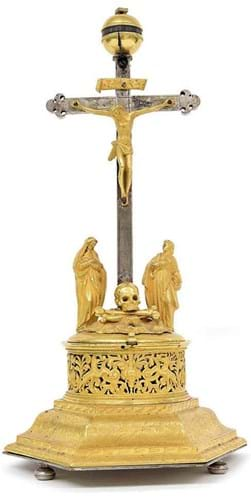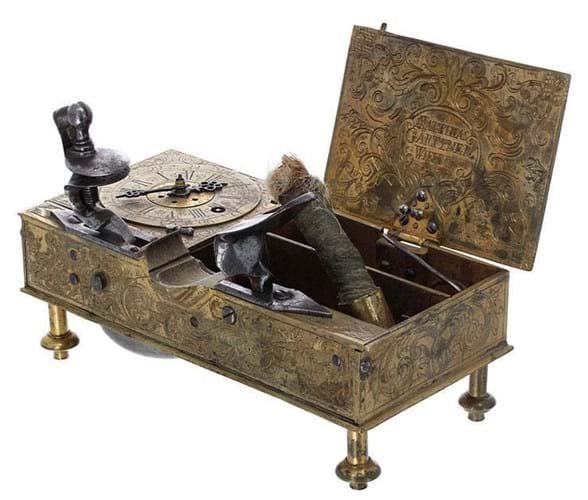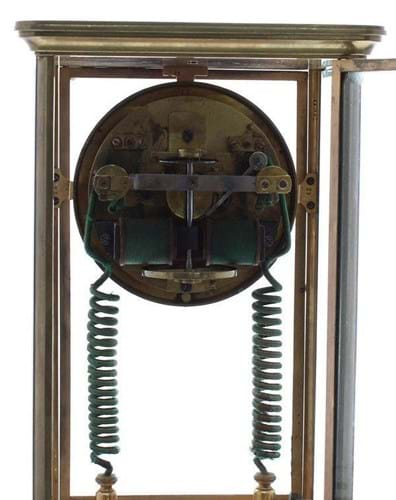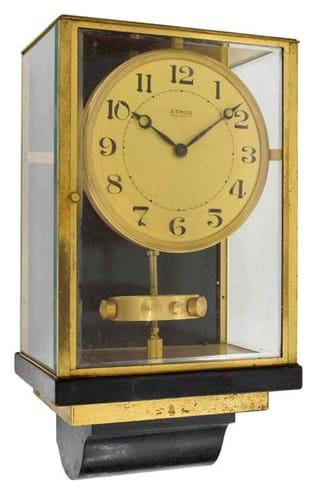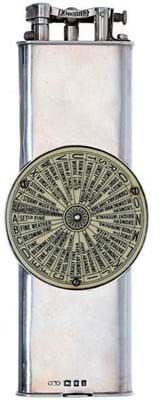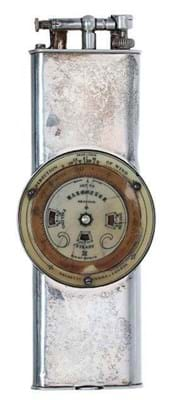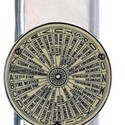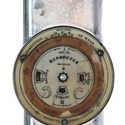Strong bidding from Continental buyers on the top lots ensured a successful reception for the mixture of relatively ancient and modern at Gardiner Houlgate’s (20% buyer’s premium) specialist clocks sale.
Dated c.1600, an Augsburg gilt metal and steel striking cruciform clock told the time on the gilt orb with a revolving silvered Roman chapter ring and blued steel pointer.
At the foot of the cross, figures of Mary and Joseph of Arimathea stood with skull and crossed bones at their feet. The ornate four-pillar, chain fusee movement in the pierced base was stamped AMW to the backplate.
The 12¼in (31cm) clock had been bought at Christie’s in 1993 for a premium-inclusive £8000. At the Corsham auction on October 24 it was pitched at £4000-6000 but sold at £13,500.
Candle alarm clock
Another return to the market after a couple of decades was a rare c.1740 gilt metal candle alarm clock, signed Zeidlmayr Wienn N. 242 to the backplate, with fusee movement, verge escapement and a standing barrel for the alarm.
The 6¼in (16cm) wide case included a box, signed to the inside of the lid Matthias Gärttner Wienn. When the alarm sounds a lever swings to open the box and a metal-cased candle springs up.
Sold at Sotheby’s in 1991 for £10,000, including premium, it was again carefully pitched at £4000-6000 but went over hopes at £11,500.
Provenanced to a 1990 Sotheby’s sale, a more conventional clock was a fine c.1770 ebonised chiming bracket clock, signed to the 6½in (16cm) enamel dial and to the repeating seven-pillar, triple fusee and chain movement Ellicott London for the highly respected father-and-son team John and Edward Ellicott.
Standing 2ft 1in 64cm) tall, the bell-top case was banded with gilt-brass and profusely decorated with gilt-brass mounts. Complete with pendulum and keys it made £8000 in 1991. Nearly three decades on it went well above estimate but sold at £7500 to a UK buyer.
Into the 20th century
Moving into the 20th century, electric clocks made an impact as they have on two or three of the last horology sales at Corsham.
Rarity and innovation are the prime targets for collectors in this field and demand was met by supply.
One such was a Shortt Synchronome astronomical regulator dated 1912, one of only 12 made.
Designed by railway engineer William Shortt and horologist Frank Hope-Junes and manufactured by the Synchronome Co, London, it was the forerunner of the world’s most accurate timepiece: the electromechanical free pendulum, Synchronome SH6 clock invented by Short and Hope-Jones in 1921. About 100 of these were made between 1922-56 and used by astronomical and naval observatories round the world.
The Corsham regulator, housed in a 4ft 7in (1.41m) mahogany case, sold with copies of Shortt’s 1911 patent and went to the Continent within estimate at £11,500.
French innovation
Two innovative French timepieces attracted attention, more than doubling top expectations.
One was a very rare 1893 patent electric mantel clock by J Cauderay, a Paris-based Swiss inventor. Such clocks are credited with the earliest successful use of an electrically maintained spring balance.
In a 12in (30cm) tall glass with a 4in (10cm) dial and featuring sweep second hand and two decorative silk covered coils leading to the battery in the base, the clock was the other UK success among the topsellers. It made £5000 against a £1200-1600 estimate.
The other French eyecatcher was an unusual early Atmos wall clock.
Atmosphere clocks, in which the mainspring is wound by the expansion and contraction of liquid in sealed bellows as outside pressure and temperature changes, have a remarkably long history. Dutch engineer Cornelis Drebbel invented the form in the early 17th century. He constructed 18 of them, one of which was owned by King James I.
They remained something of a sideshow in the history of horology but improvements continued and the one at Otago University in Dunedin, New Zealand, is still running despite not having been manually wound since its construction in 1864.
The wall clock at Gardiner Houlgate dated from c.1929 and bore a metal plaque verso inscribed Brevets J.L. Reutter S.G.D.S., Made in France and with a 5¾in (14.5cm) gilt dial signed Atmos Pendule Perpetuelle.
Reutter deigned the prototype driven by a mercury in-glass expansion device in 1928 and production of the Atmos clocks by the Compagnie Générale de Radio company began in 1929. Production switched to Jaeger-Le Coultre in 1935 and production of Atmos clocks continues with more than half a million made to date.
At Corsham the forerunner in a 16in 41cm) tall ebonised, glass and brass-bound case was estimated at £1500-2500 and went back to Europe at £5800.
Light rarity
Perhaps the rarest item at Gardiner Houlgate’s sale was a Dunhill lighter with a built-in 2in (5cm) barometer (back and front views shown above). Possibly a one-off made for a special commission, the 5½in (14cm) silver case was marked WFW [for William F Wright] London 1926 and Patent no 143752. Estimated at £1500-2500, it sold at £4400.


